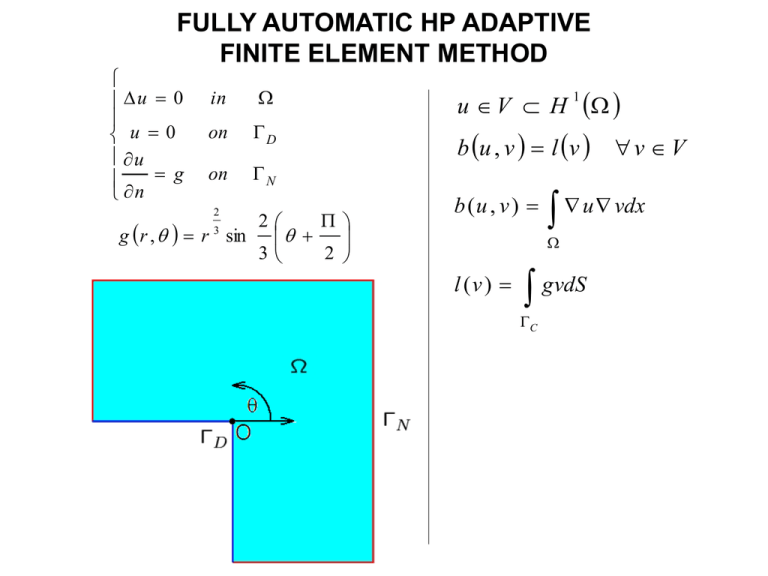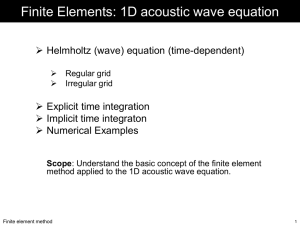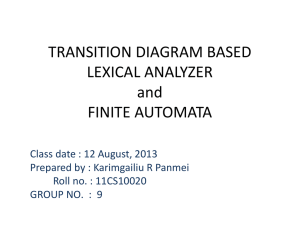wyklad1
advertisement

FULLY AUTOMATIC HP ADAPTIVE FINITE ELEMENT METHOD u 0 u 0 u g n in on D on N 2 g r , r 3 sin 2 3 2 b u , v l v v V u V H b (u , v ) 1 u vdx l (v ) gvdS C FINITE ELEMENT METHOD DISCRETIZATION The Finite Element Method (FEM) consists in construction of the finite dimensional sub-space V hp V We seek the approximate solution as a linear combination i of the V basis functions e hp hp 21 u hp V hp u u hp i 1 i i u hp e hp HP ADAPTATIONi Goal: increase the number N h p of the basis functions e h p in order to increase the accuracy of the approximate solution N hp u u hp i 1 i i u hp e hp hp adaptation consists in breaking selected finite elements into smaller elements and increasing polynomial order of approximation on selected finite elements. FULLY AUTOMATIC HP ADAPTIVE FINITE ELEMENT METHOD Coarse mesh FULLY AUTOMATIC HP ADAPTIVE FINITE ELEMENT METHOD Coarse mesh solution FULLY AUTOMATIC HP ADAPTIVE FINITE ELEMENT METHOD Fine mesh FULLY AUTOMATIC HP ADAPTIVE FINITE ELEMENT METHOD Fine mesh solution FULLY AUTOMATIC HP ADAPTIVE FINITE ELEMENT METHOD Optimal mesh is constracted based on comparison of coarse and fine mesh solutions FULLY AUTOMATIC HP ADAPTIVE FINITE ELEMENT METHOD Final mesh delivering solution with 0.001 relative error FULLY AUTOMATIC HP ADAPTIVE FINITE ELEMENT METHOD Zoom 10 X FULLY AUTOMATIC HP ADAPTIVE FINITE ELEMENT METHOD Zoom 100 X FULLY AUTOMATIC HP ADAPTIVE FINITE ELEMENT METHOD Zoom 1000 X FULLY AUTOMATIC HP ADAPTIVE FINITE ELEMENT METHOD Zoom 10000 X FULLY AUTOMATIC HP ADAPTIVE FINITE ELEMENT METHOD Zoom 100000 X FULLY AUTOMATIC HP ADAPTIVE FINITE ELEMENT METHOD Zoom 1000000 X LOKALNY WYBÓR OPTYMALNEJ STRATEGII ADAPTACJI Element siatki rzadkiej Lokalne rozwiązanie na elemencie siatki rzadkiej Element siatki gęstej Lokalne rozwiązanie na elemencie siatki gęstej u h, p uh 2 , p 1 Lokalnie, dla każdego elementu siatki rzadkiej rozważane są różne strategie adaptacji Dla proponowanych strategii adaptacji obliczam lokalne rozwiązanie poprzez mechanizm projekcji z rozwiązania na siatce gęstej w ??? w uh 2 , p 1 (mechanizm projekcji) (dla proponowanych strategii adaptacji) Lokalnie, dla każdego elementu siatki rzadkiej, u h , p 1 u h , p u h , p 1 w 2 2 wybierana jest taka strategia, która daje nam max największy spadek błędu a jednocześnie najmniejszy nrdof przyrost rozmiaru zadania (ilości niewiadomych) HP ADAPTATION PROVIDES EXPONENTIAL CONVERGENCE RATE 3D Fichera problem u 0 u 0 u g n 2 g r , r 3 sin w na D na N u 0 u 0 u g n 2 3 2 Laplace equation w na D na N 3D Fichera problem 3D Fichera problem 3D Fichera problem Solution over the coarse grid + => + => Solution over the fine grid Optimal grid Relative error estimation (energy norm) Decisions about optimal h, p or hp refinements over each coarse grid finite element 3D Fichera problem 3D Fichera problem 3D Fichera problem Solution over the coarse grid + => + => Solution over the fine grid Optimal grid Relative error estimation (energy norm) Decisions about optimal h, p or hp refinements over each coarse grid finite element 3D Fichera problem 3D Fichera problem 3D Fichera problem 3D Fichera problem Results for 3D Fichera problem Convergence curve for the 3D Fichera problem Exponential convergence delivered by parallel code Corresponding fine mesh solution has relative error below 1% EXEMPLARY BOUNDARY VALUE PROBLEM HEAT TRANSFER OVER THE L-SHAPE DOMAIN Strong formulation (Partial Differential Equations) Find R x u x R temperature scalar field, such that 2 where is the L-shape domain u 0 in on D u 0 u g on N boundary N D n On D part of the boundary we define the Dirichlet boundary condition (zero temperature) N On N part of the boundary we define the Neumanna boundary condition (heat transfer rate) 2 2 g r , r sin 3 2 3 STRONG AND WEAK (VARIATIONAL) FORMULATIONS Strong formulation Find u temperature scalar field, of the order of C 2 such that u 0 in on D u 0 u g on N n 2 V v L : v 2 v 2 dx : tr v 0 on D Weak (variational) formulation Find u V temperature scalar field such that b u , v l v b (u , v ) v V u v dx l (v ) g v dS N FINITE ELEMENT METHOD DISCRETIZATION The Finite Element Method (FEM) consists in construction of the finite dimensional sub-space V hp V We seek the approximate solution as a linear combination i of the V basis functions e hp hp 21 u hp V hp u u hp i 1 i i u hp e hp Finite element discretization b u , v l v v V u V H 1 u hp V hp H 1 N hp u u hp i i u hp e hp i 1 i u hp , i 1,..., N hp global degrees of freedom v e hp , j 1,..., N hp j N hp b e hp , e hp l e hp i j j j 1,..., N hp i 1 b (u , v ) k u vdx b ( e hp , e hp ) u hp k e hp e hp dx i j i l (v ) C gvdS i l ( e hp ) j C j ge hp dS j MESH STRUCTURE Mesh is based on Euler’s model: • finite element is composed of nodes • nodes are: vertices, edges, faces, interiors etc. • edge consists of 2 vertices • face consists of 4 edges • interior consists of (i.e. is delimited by) 6 faces • … face interior edge vertex SHAPE FUNCTIONS The base of approximation space is composed of global base functions. These are splines, made of multi-dimensional polynomials. Global base functions are connected with a node and have supports of one or several neighbor elements. (2D example) global base functions based on vertices global base functions based on edges global base functions based on faces SHAPE FUNCTIONS Shape function is a restriction of a GBF into a single finite element. Shape functions are connected with elements, and are just single multi-dimensional polynomials K2 ,1 (2D example) For example: global edge base function 8 e hp consists of two local 1 1K, 2 1 K shape functions: 1K, 2 and K0 , 2 2 ,1 K2 1 0,2 2 K K2 ,1 2 ,0 3 2 K 0,2 3 Typically in 2D we use shape functions of orders up to (9, 9). Bilinear local shape functions are obligatory for each element. (not all functions are shown in the pictures for clarity) 2 Relations between 1D 2D and 3D shape functions Higher dimension shape functions are constructed as tensor products of several 1D shape functions 1D Hp Finite Element 1D hierarchical shape functions: 2D Hp Finite Element 4 vertices 4 mid-edge nodes 1mid-face nodes The reference element shape functions are created as tensor products of 1D hierarchical shape functions 2D Hp Finite Element Vertex shape functions and second order edge and interior shape functions 1 e hp 3 e hp 5 e hp 2 e hp 4 e hp 8 e hp 7 9 e hp e hp 14 e hp 16 e hp 17 e hp 2D Hp Finite Element One bilinear shape function for each of 8 vertices (order of approximation equal to 1 in each vertex) 2D Hp Finite Element shape functions for each of 4 mid-edge nodes (various orders of approximation) 2D Hp Finite Element face bubble shape functions for interior node Relations between 1D and 2D Higher dimension shape functions are constructed as tensor products of several 1D shape functions 3D Fichera problem u 0 u 0 u g n 2 g r , r 3 sin w na D na N u 0 u 0 u g n 2 3 2 Laplace equation w na D na N 3D Hp Finite Element 8 vertices 12 mid-edge nodes 6 mid-face nodes 1 middle node The reference element shape functions are created as tensor products of 1D hierarchical shape functions 3D Hp Finite Element One trilinear shape function for each of 8 vertices (order of approximation equal to 1 in each vertex) 3D Hp Finite Element shape functions for each of 12 mid-edge nodes (various orders of approximation) 3D Hp Finite Element face bubble shape functions for each of 6 mid-face nodes 3D Hp Finite Element bubble shape functions for the middle node Relations between 1D and 3D Higher dimension shape functions are constructed as tensor products of several 1D shape functions Using templates as an unification tool Vertices, edges and interiors for different dimensions are created as instantiation of general Vertex, Edge or Face template Summary of shape functions dependencies Higher order shape functions are created as tensor products of one dimensional shape functions Summary of shape functions dependencies Dimension independent code computing shape function value Using templates as an unification tool Deriving dimension independent code creating the stiffness matrix and rhs Using templates as an unification tool Deriving dimension independent code creating the stiffness matrix and rhs Using templates as an unification tool Deriving dimension independent code creating the stiffness matrix and rhs Using templates as an unification tool Deriving dimension independent code creating the stiffness matrix and rhs








